

Taller de Tesis: Desarrollo del Proyecto e Informe Final. Promoting Student Engagement by Integrating New Technology into Tertiary Education: The Role of the iPad. Promoting Student Engagement by Integrating New Technology into Tertiary Education: The Role of the iPad Maurizio Manuguerra, Peter Petocz Abstract Teachers in tertiary education need new strategies to communicate with students of the net generation and to shape enticing educational experiences for them.
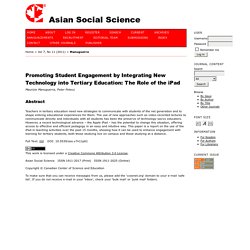
iPads on Practicum: Perspective of a Student-Teacher. The PDF file you selected should load here if your Web browser has a PDF reader plug-in installed (for example, a recent version of Adobe Acrobat Reader).
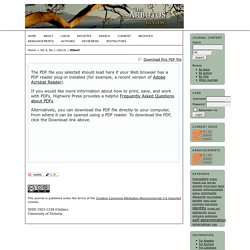
If you would like more information about how to print, save, and work with PDFs, Highwire Press provides a helpful Frequently Asked Questions about PDFs. Alternatively, you can download the PDF file directly to your computer, from where it can be opened using a PDF reader. To download the PDF, click the Download link above. Fullscreen Fullscreen Off. Teaching with tablets: A brave new world? Professors Megan Mahowald and Deborah Getz had surprises waiting when their students showed up in January.
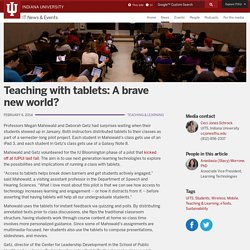
Both instructors distributed tablets to their classes as part of a semester-long pilot project. Each student in Mahowald's class gets use of an iPad 3, and each student in Getz's class gets use of a Galaxy Note 8. Mahowald and Getz volunteered for the IU Bloomington phase of a pilot that kicked off at IUPUI last fall. The aim is to use next generation learning technologies to explore the possibilities and implications of running a class with tablets.
"Access to tablets helps break down barriers and get students actively engaged," said Mahowald, a visiting assistant professor in the Department of Speech and Hearing Sciences. The Challenges of 1:1 in the Classroom. Login or Create New Account Member Spotlights RIT Launches Nation’s First Minor in Free and Open Source Software and Free Culture Partner News NMC Partners with the Balboa Park Online Collaborative iTUNES U.
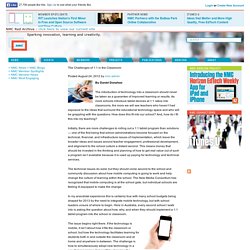
The Positive Impact of Launching a 1-1 iPad Project – The Data from Hove Park School. In April 2013 Hove Park School launched a 1-1 iPad deployment for 1600 students.

What has been the impact on progress, behaviour and attitudes to learning? Student Achievement Evidence based on the tracking of achievement data shows that the introduction of Hove Park’s 1-1 iPad Learning Transformation Project has made a positive contribution to the school’s work to eliminate the gap between the progress of economically disadvantaged students and their peers. Since the introduction of iPads 1-1 the progress of students eligible for pupil premium funding has accelerated compared to the progress of the cohort as a whole. Student Behaviour Analysis of behaviour data at Hove Park has shown that the use of iPads has resulted in a significant decrease in sanctions across the school for the first two terms working 1-1 compared with the same period in 2012. Ipad/pdf/iPad_report_Karsenti-Fievez_EN.pdf. Www.edutopia.org/pdfs/guides/edutopia-guia-aprendizaje-dispositivos-mobiles-espanol.pdf. El uso del móvil para el aprendizaje. Just what does NIST consider a mobile device?
Just what does NIST consider a mobile device?
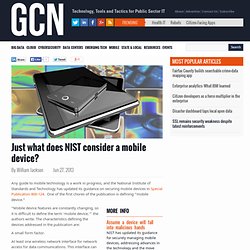
By William JacksonJun 27, 2013 Any guide to mobile technology is a work in progress, and the National Institute of Standards and Technology has updated its guidance on securing mobile devices in Special Publication 800-124. One of the first chores of the publication is defining “mobile device.” “Mobile device features are constantly changing, so it is difficult to define the term ‘mobile device,’” the authors write. The characteristics defining the devices addressed in the publication are: A small form factor. At least one wireless network interface for network access for data communications. Local non-removable data storage. An operating system that is not a full-fledged desktop or laptop operating system. Applications provided with the mobile device, accessed through a Web browser or acquired and installed from third parties. Other common characteristics include: About the Author. Xplore Full-Text PDF: Digital Library. Pdf_80. Dispositivos Móviles.
NIST.SP.800-124r1.pdf. Theory of Planned Behavior. Mobile Learning: Estadísticas que le harán replantearse su estrategia de capacitación. Mobile Learning: Estadísticas que le harán replantearse su estrategia de capacitación No hay duda de que los dispositivos móviles están cambiando la capacitación corporativa.
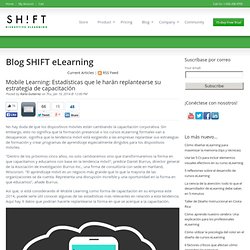
Sin embargo, esto no significa que la formación presencial o los cursos eLearning formales van a desaparecer, significa que la tendencia móvil está exigiendo a las empresas replantear sus estrategias de formación y crear programas de aprendizaje especialmente dirigidos para los dispositivos móviles. "Dentro de los próximos cinco años, no solo cambiaremos sino que transformaremos la forma en que capacitamos y educamos con base en la tendencia móvil", predice Daniel Burrus, director general de la Asociación de Investigación Burrus Inc., una firma de consultoría con sede en Hartland, Wisconsin. "El aprendizaje móvil es un negocio más grande que lo que la mayoría de las organizaciones se da cuenta. Representa una disrupción increíble y una oportunidad en la forma en que educamos", añade Burrus. 1. 2. 3. 4.
Aprendizaje móvil: Mobile Learning. Diseñar experiencias de aprendizaje movil. - ¿Qué sabemos del uso educativo de las tabletas? (metainvestigació... Papersff2.indd - 14.pdf. Www.um.es/ead/red/31/zapata_ros.pdf. Mobile Learning Publications. UNESCO Mobile Learning Publications Today there are over six billion mobile phone subscriptions worldwide, and for every one person who accesses the internet from a computer two do so from a mobile device.

Given the ubiquity and rapidly expanding functionality of mobile technologies, UNESCO is enthusiastic about their potential to improve and facilitate learning, particularly in communities where educational opportunities are scarce. This Working Paper Series scans the globe to illuminate the ways in which mobile technologies can be used to support the United Nations Education for All Goals; respond to the challenges of particular educational contexts; supplement and enrich formal schooling; and make learning more accessible, equitable, personalized and flexible for students everywhere. Unesdoc.unesco.org/images/0021/002196/219641E. Mobile Learning - A Brief History of Learning With Mobile Computers. The idea of using computerised mobile devices to support learning was formally conceptualised a surprisingly long time ago.
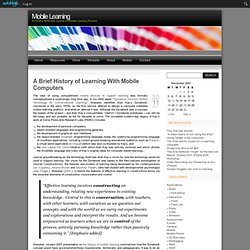
In his 2002 paper “Disruptive Devices: Mobile Technology for Conversational Learning,” Sharples identifies Alan Kay’s Dynabook, conceived in the early 1970s, as the first serious attempt to design a computer-mediated mobile learning platform. And what an attempt it was. Although the Dynabook was a concept, the ripples of the project – and Alan Kay’s (non-portable, “interim”) Dynabook prototypes – can still be felt today, and will probably be felt for decades to come. Mobile Learning em Química: uma análise acerca dos aplicativos disponíveis para tablets. Turkish Online Journal of Distance Education-TOJDE October 2007 ISSN 1302-6488 Volume: 8 Number: 4 - article_11.pdf. ECAR National Study of Undergraduate Students and Information Technology, 2011 Report. Key Findings The ECAR study of undergraduate students and information technology sheds lights on how information technology affects the college experience.
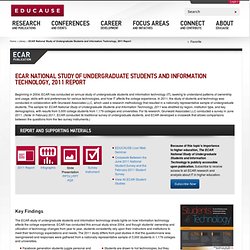
ECAR has conducted this annual study since 2004, and though students' ownership and utilization of technology changes from year to year, students consistently rely upon their instructors and institutions to meet their technology expectations and needs. The 2011 study differs from past studies in that the questionnaire was reengineered and responses were gathered from a nationally representative sample of 3,000 students in 1,179 colleges and universities. Experiential Mobile Learning Activities: Presentation Materials. Ten ideas for mobile learning. Microsoft Word - 107-RCF.doc - 107-RCF.pdf. Mobile Learning. Three generations of distance education pedagogy. Special Issue - Connectivism: Design and Delivery of Social Networked Learning Terry Anderson and Jon Dron Athabasca University, Canada Abstract This paper defines and examines three generations of distance education pedagogy.
Unlike earlier classifications of distance education based on the technology used, this analysis focuses on the pedagogy that defines the learning experiences encapsulated in the learning design. The three generations of cognitive-behaviourist, social constructivist, and connectivist pedagogy are examined, using the familiar community of inquiry model (Garrison, Anderson, & Archer, 2000) with its focus on social, cognitive, and teaching presences. Mobile Learning infokit / Frameworks for mobile learning. In order to move from academic theorising about mobile learning to operational and successful use frameworks are necessary. There are a variety of such frameworks and, before introducing several which educational institutions may find useful, it is worth recapping a Futurelab overview from 2004 outlining six broad theory-based categories of activity. Knowing what it is that’s driving the change you want to see enables successful evaluation of mobile learning initiatives: Whilst some initiatives may see mobile learning as a way to foster collaborative interactions, others may foreground more behaviourist approaches.
It is possible, of course, to blend several categories of activity (although this may make the initiative more difficult to evaluate). The International Review of Research in Open and Distance Learning. Mobile Technology for Children: Designing for Interaction and Learning - Allison Druin. Children are one of the largest new user groups of mobile technology -- from phones to micro-laptops to electronic toys. These products are both lauded and criticized, especially when it comes to their role in education and learning. The need has never been greater to understand how these technologies are being designed and to evaluate their impact worldwide.
Mobile Technology for Children brings together contributions from leaders in industry, non-profit organizations, and academia to offer practical solutions for the design and the future of mobile technology for children. *First book to present a multitude of voices on the design, technology, and impact of mobile devices for children and learning *Features contributions from leading academics, designers, and policy makers from nine countries, whose affiliations include Sesame Workshop, LeapFrog Enterprises, Intel, the United Nations, and UNICEF. Magic in the Air: Mobile Communication and the Transformation of Social Life - James Everett Katz. In this timely volume, James E. Katz, a leading authority on social consequences of communication technology, analyzes the way new mobile telecommunications affect daily life both in the United States and around the world. Magic in the Air is the most wide-ranging analysis of mobile communication to date. Katz investigates the spectrum of social aspects of the cell phone's impact on society and the way social forces affect the use, display, and re-configuration of the cell phone.
Surveying the mobile phone's current and emerging role in daily life, Katz finds that it provides many benefits for the user, and that some of these benefits are subtle and even counter-intuitive. He also identifies ways the mobile phone has not been entirely positive. In keeping with the book's title, Katz explores the often overlooked psychic and religious uses of the mobile phone, an area that has only recently begun to command scholarly interest. James E. The Evolution of Mobile Teaching and Learning. From Distraction to Engagement: Wireless Devices in the Classroom (EDUCAUSE Quarterly.
Track Descriptions. Since the ConnectEd Summit will focus on discussion-based workshops, participants will follow a single program track across all of the schedule Summit workshop sessions. If you have questions about any of the tracks, you may click on the organizer's name to send an email. Teaching: Pedagogy & Praxis Track Facilitators: Dr. Eric Mazur, Harvard University; Dr. Derek Bruff, Vanderbilt University; Berlin Fang, Oklahoma Christian University; Mark Scott, Freed-Hardeman University; and Dr. The 2008 Horizon Report stated, “As new devices ... are released that make content almost as easy to access and view on a mobile as on a computer, the demand for mobile content will continue to grow.
Mobile Devices: Facing Challenges and Opportunities for Learning. Mobile Devices: Facing Challenges and Opportunities for Learning By Patricia Deubel03/19/09 ##AUTHORSPLIT## <---> According to Will Richardson (2008) "Our students must be nomadic, flexible, mobile learners who depend not so much on what they can recall as on their ability to connect with people and resources and edit content on their desktops, or even more likely, on pocket-size devices they carry around with them" (p. 18). As I agree with that assessment, it became disturbing to read House Bill 363, introduced to the General Assembly of Pennsylvania on February 11, 2009, to ban students' possession of "telephone paging devices, commonly referred to as beepers, cellular telephones and portable electronic devices that record or play audio or video material" on "school grounds, at school sponsored activities and on buses or other vehicles provided by the school district.
" It's easy to find teacher reactions to the bill. I'd join the ranks of those opposing it.